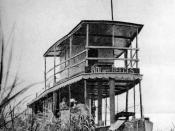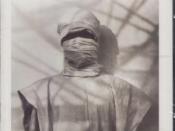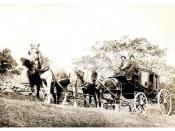The Night Journey in Heart of DarknessHeart of Darkness, by Joseph Conrad, has been illustrated as a night journey or a story of initiation, in which man proceeds to experience preceding from innocence and deeply appreciates goodness as he becomes acquainted with the nature of evil. The conception of darkness, which is symbolic of evil, is presented metaphorically, literally, and notably psychologically. The novel may be described as an expedition into the mind, which the reader experiences through Marlow, the protagonist. As a 'night journey', the novella informs the reader that all men are capable of abhorrence, of abomination. Conrad effectively illustrates one man's acquaintance with evil through the literary concepts of characterisation, symbol, writer in context, ideology and, reader positioning and the point of view.
There are essentially only two characters that are significant to the notions and plot of Heart of Darkness, namely Marlow and Kurtz.
The two characters are distinctly different from each other, although both are equally characterised with physical and mental traits by Conrad. The reader is involved with the interaction between the two characters. As I support the thesis that man moves from innocence to experience and becomes acquainted with evil in the novella, I have interpreted the character of Marlow as the embodiment of good, and Kurtz as that of evil, (although not entirely).
The events of the night journey of Heart of Darkness are described through the character of Marlow who acts as a mediator as he tells the story. Depth and meaningfulness are given in the text, through Marlow's function, serving as a conciousness.
Even before the journey to the Congo, Marlow provides a sense of depravity when he comments (on page 33) that Africa 'â¦had become a place of darkness.' Marlow further describes the Congo as 'â¦a mighty big riverâ¦resembling an immense snake uncoiled, with its head in the sea, its body at rest curving afar over a vast country, and its tail lost in the depths of the land.' The winding elaborateness of the river is symbolic of an entrance to a mysterious place, a shapely body that is usually beautiful; and so Marlow says that 'The snake had charmed me,' (pg 33).
In Chapter One of the novella, when Marlow encounters the two women knitting black wool, he is troubled by their 'swift and indifferent placidity' (pg 36) and, their 'unconcerned wisdom' (pg37). The knitters are characters who hold symbolic roles as discretely sinister figures linked with 'darkness'. When Marlow meets them he says that an 'eerie feeling' (pg37) came over him. He describes one knitter as 'uncanny and fateful' (pg37), and had the notion that the two women were 'guarding the door of Darkness, knitting the black wool as for a warm pallâ¦' (pg 37). It is symbolic that the wool the women are knitting, is black; a colour often prescribed as something sinister, dark and evil. It is often thought that evil deeds are committed during night; darkness. To enhance the notion of darkness, Marlow associates the house (where he encounters the knitters) with darkness he remarks, 'the house was as still as a house in a city of the dead' (pg 37). The knitters 'guarding the door of darkness' are often seen as the Fates in Greek mythology, the goddesses who spin threads of men's lives and thus determining their fate.
The natives in the text hold symbolic roles as they are mistreated by 'whites', generally caucasians who possess authority over them. The evil in such acts is one of the discoveries of Marlow. The natives under the control of white authorities are depicted as products of their mistreatment which is notable when Marlow describes their condition in Chapter One, 'They passed me within six inches, without a glance, with that complete, deathlike indifference of unhappy savages' (pg 43). The natives, who are referred to as 'savages' in this quote appear to lack expression and display a 'deathlike indifference' which may be a result of evil actions imposed on them. On this same page, Marlow pronounces imagery of hell when he says, 'I've seen the devil of violence, and the devil of greed, and the devil of hot desire; but, by all the stars! These were strong, lusty, red-eyed devils, that swayed and drove men - men, I tell you.' Marlow is acquainted with the evil of men, because he further states, 'I foresaw that in the blinding sunshine of that land I would become acquainted with a flabby, pretending, weak-eyed devil of a rapcious and pitiless folly.' Devils come from Hell, a place which is dark and sinister. It is the 'weak-eyed devil' that Marlow refers to 'white men' as; thus providing the reader with the notion that all men are capable of depravity, evil, abomination.
Through the events in which Marlow is acquainted with evil, he sheds his innocence in order for experience. Another event in which the protagonist witnesses evil is when he encounters dying natives who 'were not enemies [and not] criminals', but were left to die, is described in Chapter One, when he describes the incident: [they were] black shadows of disease and starvation, lying confusedly in the greenish gloom.' There is an obvious connection between the 'black shadows' and 'gloom' , with darkness.





